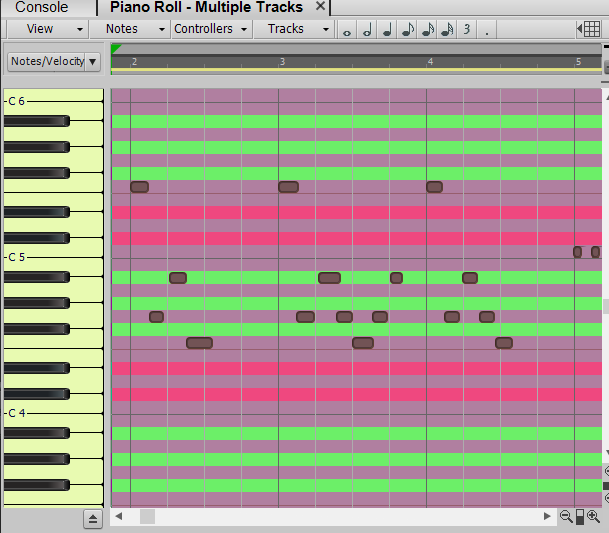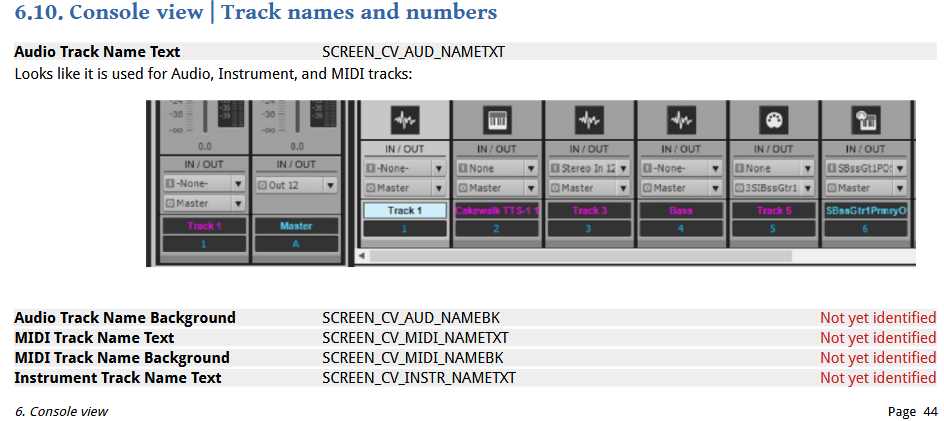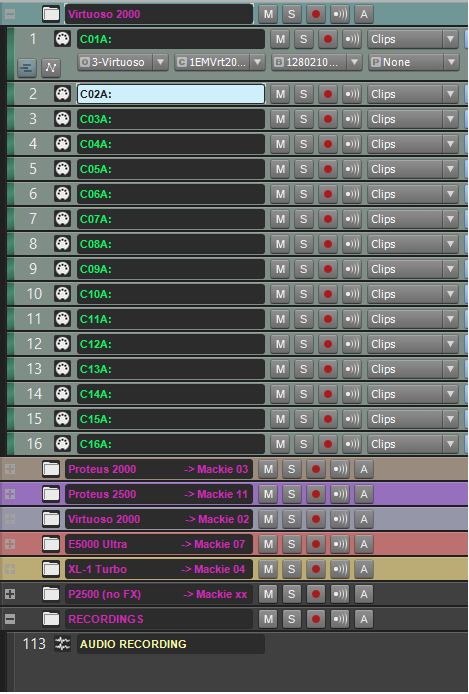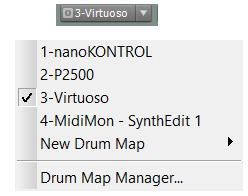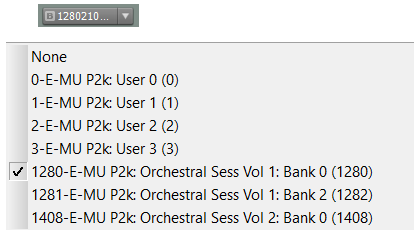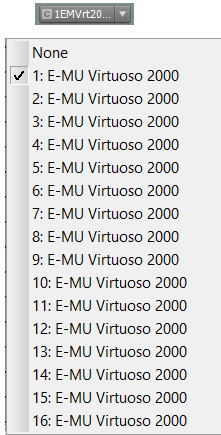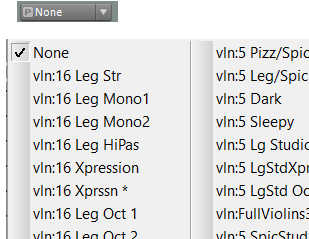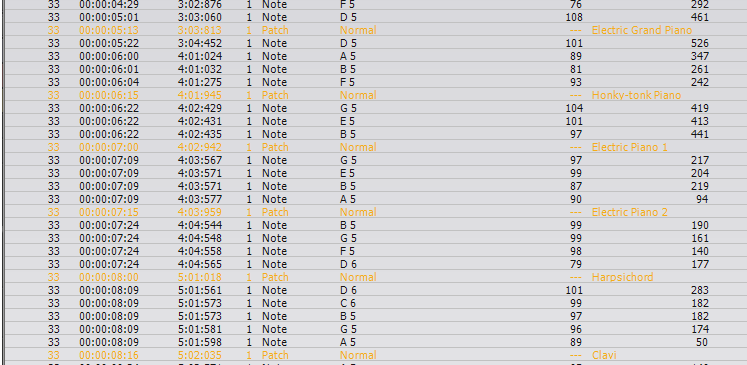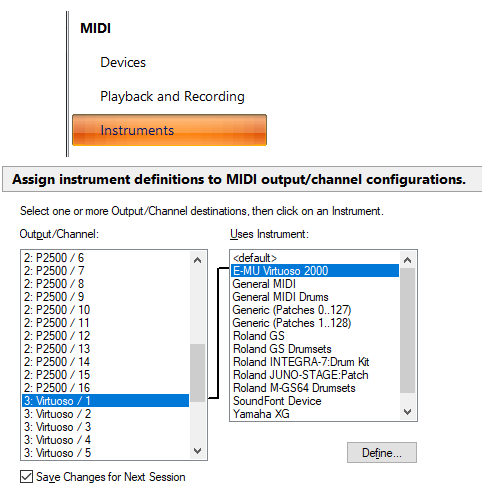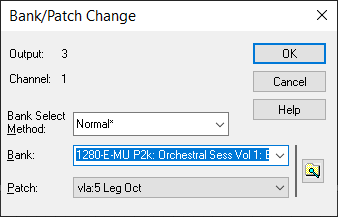-
Posts
6,062 -
Joined
-
Days Won
1
Everything posted by user905133
-
A few months ago (as a plain old user who likes to explore possibilities such as this), I played with some of the color settings for the PRV using the Theme Editor. If the ability to alternate colors from measure to measure exists, I didn't stumble onto it. I encourage you to check out Colin Nicholls' Theme Editing Guide-in-Progress as a start and the Theme Editor as a follow up.
-

Track automation: limited to Volume and Pan?
user905133 replied to Astral's topic in Cakewalk by BandLab
-
I also got a 404 error. I was able to DL the Themes pdf, not this. Also, I was able to read your blog. Do you have an index page with links to various resources?
-

documentation Young Lady's Illustrated Primer to Theming Cakewalk
user905133 replied to Colin Nicholls's topic in UI Themes
BTW, I am 96% certain that at one point a I had different colors for the CV Names for the MIDI and AUDIO. I have tried to get that back, but I have not been able to. As you discovered, audio, instrument, and midi now all have the same NAMETXT color. At one point I had one green and one default blue in TV, but had reversed them in CV. I tried to change it so CV and TV track names were in the same color, but have not been able to get it back. The earliest full installer I have is 2019.11. If I had earlier ones, I'd test them. I have tried *.col / colors, too. Nice work in the newest edition!!! Others should be aware that you are changing the file where you have it stored, so the edit date of Post # 1 in the thread has not been changing. This works for me, but might confuse others if they are going by the edit date of Post #1 (above)/ -

MIDI: Possible to edit time values for groups of notes?
user905133 replied to Michael McBroom's topic in Cakewalk by BandLab
ooops -
I will assume by "online DAW" you mean Bandlab. I have looked at it and tested a few things in it. I think for someone starting out, it should be easier to learn than Cakewalk. It was quite frustrating for me for two reasons: (1) I have experience with the Cakewalk/SONAR/Cakewalk by Bandlab line of products, so I had to spend time trying to learn how to do in Bandlab what I already knew how to do in Cakewalk/SONAR and (2) based on my prior usage, I found Bandlab didn't seem to give me the control over what I wanted to do that I had with Cakewalk/SONAR. However, I found it to be far more accessible and intuitive than other music production/recording software I purchased but have never been able to use. Also, I took note of the social aspects of Bandlab and have it on my personal to-do list to learn the ins and outs of collaborating via Bandlab. I like that Bandlab projects [or whatever they are called there] can be exported and then opened in Cakewalk (and presumably vice versa). I barely scratched the surface of Bandlab, but I see value in it. Apologies if by "the online DAW" you did not mean Bandlab.
-
There's more, depending on the user's workflow, setup, etc. Only 1/2 way done! I will leave this as is for the time being (except for the "to be completed" comment). Maybe its enough to help. If not, I set up my P2500 to verify accuracy of the methods, so can add the other 1/2 if requested.
-
The clarification makes sense. In a nutshell, the channel is not defined in the Instrument Definition. The Instrument definition is selected for use within Cakewalk. As the screen shot from Preferences shows, the 16 midi channels for each port/device can be assigned a previously designed Instrument Definition. I think of it as a linear process: (1) Define Instrument, (2) Assign Instrument Definition to a Port/Device + channel(s), (3) Assign a Track Output to a Port/Device, (4) Assign a Track to either a specific midi channel or to None [if using the channel from the midi data itself, such as the case with a multi-channel track], (5) Assign an initial Bank/Patch if using a forced midi channel approach, or None if track has up to 16 channels of midi data. ------------------------ Auditioning individual patches on a single channel . . . . It depends on workflow, how the user has the track/project configured, and where in the tune/performance process the audition is being done. For example, this past year when I was getting back into Cakewalk and setting up an assortment of multitimbral synths--each with up to 32 midi channels, I created a template. The idea was to have all modules in folders with all midi channels available per midi port as a starting point. --------------------------- Forced-channel Template Method With the forced channel template, I can use the track control/widgets to make selections from the track itself. That way the initial bank + preset/patch can be saved on each track within a project. Note: During the setup phase, I can use my keyboard to audition sounds (1) by changing the channel it is sending on and (2) by using preset change buttons. Also, I can play notes and record patch changes as well. If I want to then make one of those banks/patches and initial track setting, I can then edit the track controls/widgets. Or, I can set the Bank and/or Patch settings to none, and then moved the desired Bank/Patch Program Change to tick zero (or wherever I want it). -------------------------- Multi-channel Track Method and other methods [to be added, if needed].
-
Sometimes the little letters [I, O, C, B, P] on the track controls/widgets for the initial bank and preset can be hard to read. Not sure if you were asking where to set up the per channel instrument assignments: You can also insert/edit Bank/Patch changes in the Event List:
-
I agree the name is misleading. There are many steep learning curves involved throughout. For the first time I now side with the people who said "Sonar" should have been retained, instead of reclaiming the old "Cakewalk" name. I do not think that this robust software can ever be a snap to learn--turn it on and instantly know how to do things.
-
One suggestion I thought of making that might fit with your workflow was having the option to have a few panes within the multidock--perhaps the ability to have 2 or 3 tabs open at the same time. I had something like that happen as a bug--one partial pane with actual functionality! I didn't report it to staff as a bug for three reasons: (1) I hadn't written up the steps to reproduced it, (2) I hadn't written up ideas on how to turn it into a feature request, and (3) I selfishly wanted to keep the "undocumented feature" for myself until I found the time to document the bug-to-be-made-as-a request. ?
- 160 replies
-
- 1
-

-
- feedback
- improvements
-
(and 5 more)
Tagged with:
-
Thanks for the very detailed explanation of how your folder patchpoint auto-routing for new audio tracks might work with several possible workflows. You address several things I wondered about in a previous thread related to auto-routing of tracks within folders. You successfully clarified several aspects of how your proposal might be implemented. Since I didn't detail my workflow and current uses of Cakewalk, there was really nothing to understand or misunderstand. Earlier today I started to reply with a description of my current Cakewalk configuration, workflow, and music development plans, but that would be out of place in this thread. I think it would be more appropriate to a forum topic on "Personal Workflows and Uses of Cakewalk." As I wrote in the previous thread on auto-routing of tracks in folders, I think this opens interesting possibilities, Since my current projects are being built within Cakewalk with four hardware buses, if this auto-patchpoint routing feature is implemented, I hope it can handle the possibility that users might not have a single default bus and the possibility that users might route different tracks within a folder to different outputs.
- 36 replies
-
- cakewalk by bandlab
- creative sauce
-
(and 2 more)
Tagged with:
-
Something like this would work, too! Or perhaps a special thread in the Tutorial section for a Topical Table-of-Contents with links to the embedded miniTutorials would work; that would save having to move them. BTW, I don't think ***** is an appropriate label to use. ? EDIT: The auto-censoring feature of this forum didn't appreciate your acronym - Attention Really Serious Enthusiasts . Evidently it didn't have the ability to detect your hidden message. ?
- 36 replies
-
- cakewalk by bandlab
- creative sauce
-
(and 2 more)
Tagged with:
-
A few months ago, someone suggested something similar. While it might work for people who have audio/instrument tracks in the same folder all following the same audio path, some users have workflows where audio goes to different paths. So, if this suggestion is implemented, I hope (1) it would be optional to have all non-exclusively midi tracks routed to one audio path and (2) it would not be the default behavior. Perhaps there could be different types of folders? Or "folder options" within one folder type? If so, it might be nice to have a "nestable" folder system so some sub-folders can have all tracks (of any type) routed through one path and other sub-folders routed differently. The best of all possible workflows! ?
- 36 replies
-
- 1
-

-
- cakewalk by bandlab
- creative sauce
-
(and 2 more)
Tagged with:
-
Is there a way for Staff to mark individual posts with consistently used generalized keywords/phrases, like "Did-you-know . . . " [DYK?] or maybe "Tips-and-tricks . . . " [TnT?] or "Often overlooked feature . . . " [OOF?] or "Mini Tutorial" [MiniT?] so users can do a search for whichever keyword/phrase is designated and go through on their own to find these kinds of gems (something sort of like an updated, forum-based "Did you know . . . " series of tips from the old SONAR line)? Just a thought.
- 36 replies
-
- 2
-

-

-
- cakewalk by bandlab
- creative sauce
-
(and 2 more)
Tagged with:
-

Time ruler format options are buggy now?
user905133 replied to Jono J Grant's topic in Cakewalk by BandLab
Sorry about any confusion I might have caused. I typed (lower case L) (ns), not ins. I should have seen that the sans serif typeface might have caused confusion; thanks for catching this and for helping to clarify it. Any idea where default.LNS gets recalled? ( BTW, I just assumed that since *.LNS [in lower case] was used for Lenses, for compatibility reasons, the extension was maintained instead of using *.wsp (or some such thing, but not *.wks!!!) for "Workspace.") Excellent to know that with "No Workspace" or "None" (or however it shows up) the ruler settings from the project's settings are in effect. -
Based on another discussion of the relocated-usb-device problem, I tried to find a tool to understand the issue better that might lead to a better solution than just taking a picture (or making a diagram) of where each usb device was plugged in. Looking at usb device properties was not very helpful, IMO. I then found this and installed it. I believe I ran it once just to see how the information was presented. I have not gone back to it, but if you are familiar with that tool and/or have any thoughts on how it might be useful for the relocated-usb-device problem (if at all), I'd be interested in your observations. Apologies for bringing this up here; I don't want to derail the problem-solving of this specific problem. So, perhaps if the View USB tool is (or might be) useful, you could create a special thread ["Third-Party Diagnostic Tools" ???] and maybe add a link to it here and maybe the other places where the issue is discussed. I have a feeling that unless/until Cakewalk (or perhaps Windows 10) has its own built-in "Locate Moved USB Devices Tool," this issue will continue to come up.
-
Some small footnotes to the discussion: (1) After seeing many comments to "widgets" in the forum, I decided to look for all references to "widgets" in the Reference Guide. I also compared those with the actual software, esp. the track controls/widgets. In the process, I saw that the definition in the glossary was seriously out-of-date. I have mental notes (and plans to return to the issue) to try to sort out the terminology and uses--for my own benefit and possibly to share with "the documentation department." (2) I know the Reference Guide Version 25.09.00 is 1712 pages, the previous one (Version 25.07.00) was 1724 pages, but the one before that (Version 25.05.00) was 2188 pages. A few months back, I did a casual comparison** to see "what was missing" from the 2188-page version and saw that the page number reduction was due to larger pages and more content on each page in the 1724 page version. **I did not do a full page-by-page comparison, but if I recall correctly the "shorter" [newer] one was tweaked a bit and also had more content due to the New Features and Fixes.
-

Control strip is now obscured by work area when docked...
user905133 replied to TK Major's topic in Feedback Loop
Thanks for looking into this!!!! -
Glad you found it useful! ? As for having your multi-dock set up the same way and saved in each project, keep in mind that you can store screen sets which are per project layouts, plus you can lock screen sets so that if you move them around temporarily , you can still return to the locked screen set. However, since Workspaces are global, you can design and save a Workspace with those panes as tabs in the multidock and then just select that Workspace. No need to do that for each project. There are a number of posts about Workspaces [formerly Lenses] you might want to read, if you haven't seen them already. If you want to leave the list, you might want to edit them one-by-one with a strikethrough for items on your list that you find out how to do. Just a thought.
- 160 replies
-
- feedback
- improvements
-
(and 5 more)
Tagged with:
-

Control strip is now obscured by work area when docked...
user905133 replied to TK Major's topic in Feedback Loop
Have you tried Expanding the Control Bar? [right click on control bar] A month or so ago I had something like what you have. I have not tested it consistently to be able to report it as a possible bug, but I seem to recall the problem happened when I had a collapsed control bar [just vertical modules like you have on the right side] and then switched something. Not sure if it was triggered by switching screensets, opening up a different project, switching to a different workspace, or what. But it looks like what you have. Basically it seemed to me that the state of the Control Bar [collapsed or expanded] was not being stored or loaded properly or something else affected the collapses/expanded state. I had totally forgotten about that issue, but I'd be interested to know if expanding the control bar solves it. If so, maybe we can figure out some consistent steps to reproduce it. Addendum: I think I remembered where I was when trying to sort this out. I will have to find the screen shots I took trying to document the oddity. Also, which version of Cakewalk are you on? I was unable to reproduce the problem and am wondering if no longer happens in 2019.11 build 63. SCREEN SHOTS (from end of November): I believe the top two might be the same problem you have here. The first one is from Cakewalk rebooted [start up; project not yet loaded]. The second one shows the Control Bar after a project was loaded. The third one shows the expanded [uncollapsed] Control Bar. Good news: it might be reproducable--from an open project with a collapsed Control Bar, I switched to my "Staff Entry Plus" Workspace and got this: ADDENDUM (a few hours after the above): More good news: I am getting this oddity repeatedly and have been documenting the steps to report as a possible bug in hopes Staff can reproduce it. If you have a specific Workspace that caused the issue you had, I'd be interested to know the results of (1) expanding the control bar and then (2) recalling the same problematic workspace. Not sure if you get the same results as I do. -
If I understand what you are asking for, this is currently possible (1) by dragging and dropping the Synth Rack and Browser onto the MultiDock and (2) by using the Docking Options and choosing Dock in MultiDock--at least on my PC. Also, the MultiDock can be undocked as a whole so the Synth Rack and Browser are there as tabs. Also, for some of your other points, have you tried (1) Screensets and (2) Workspaces? I have quite a number of workspaces with very different Control Bar Settings and when I load them up, the Control Bars are fairly consistent in returning to the ways they were stored.
- 160 replies
-
- 1
-

-
- feedback
- improvements
-
(and 5 more)
Tagged with:
-

Time ruler format options are buggy now?
user905133 replied to Jono J Grant's topic in Cakewalk by BandLab
Before a few months ago, I almost never explored using the different time ruler formats and never had more than one displayed at a time. So, thanks for asking the questions and for the various comments. It now seems to make sense to me. As best as I can tell: (1) The + and - let you change the number of time-lines (1, 2, 3, or 4) and select specific formats you want to add or remove. (2) Right-clicking on the time line let's you choose which format(s) you want displayed. However, this method does not let you change the number of time-lines. If there are two time-lines selected, the different formats of those two time-lines can be checked and unchecked, but there will always be 2, unless one is removed with the - button (or 1 or 2 added with the + button). That being said, Workspaces might also be involved in what seemed to be random, but if the idea was to uncheck one of the formats using method (2), I was only able to reduce or increase the number of scales using method (1). Again, this is totally new to me, but I just tripled tested the above and it seems to be consistent (at least on my PC). I have no idea if the above has changed over the years. I defer to others on that. Addendum: The on line Time Ruler description seems to match my trial-and-error testing. -
I get that error message, too. It's basically saying Cakewalk cannot access the device because another program [such as MIDI-OX] is using it.
-
If it were me, I'd check with Novation to see if you can get the full midi specs. I have seen discussions of MIDI 2.0 online, but I thought that was supposed to be 100% compatible with MIDI 1.0. On my usb keyboard (Evolution MK-249C) a light test chord had a velocity of 5 and a hard test chord had a velocity of 71 hex [113 dec].


